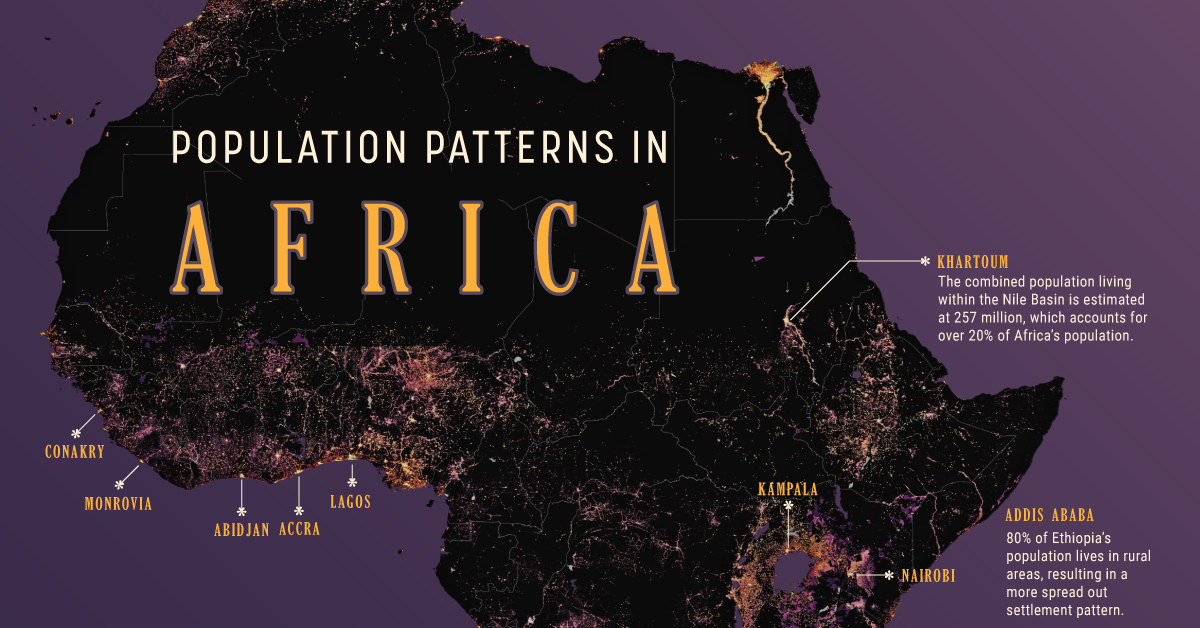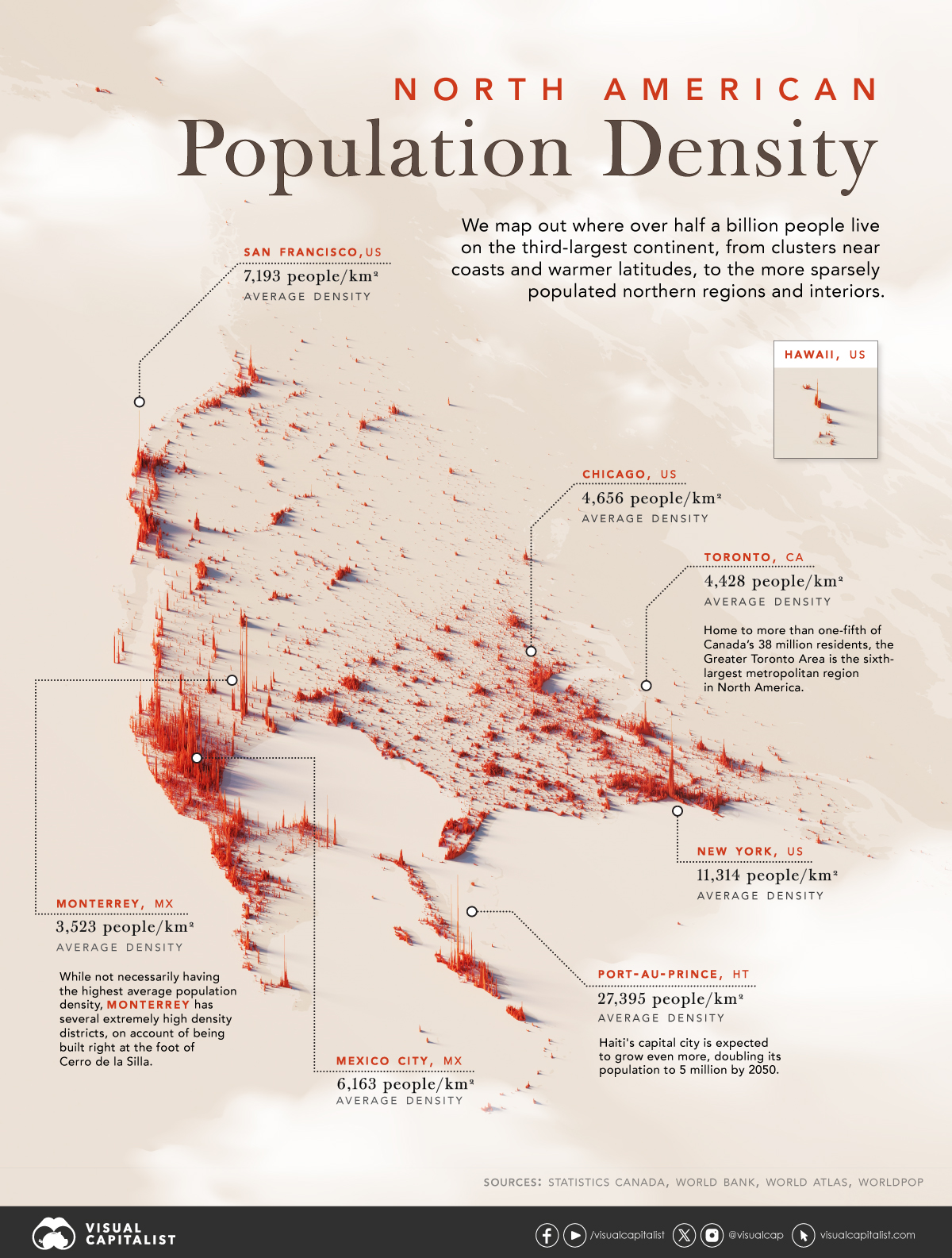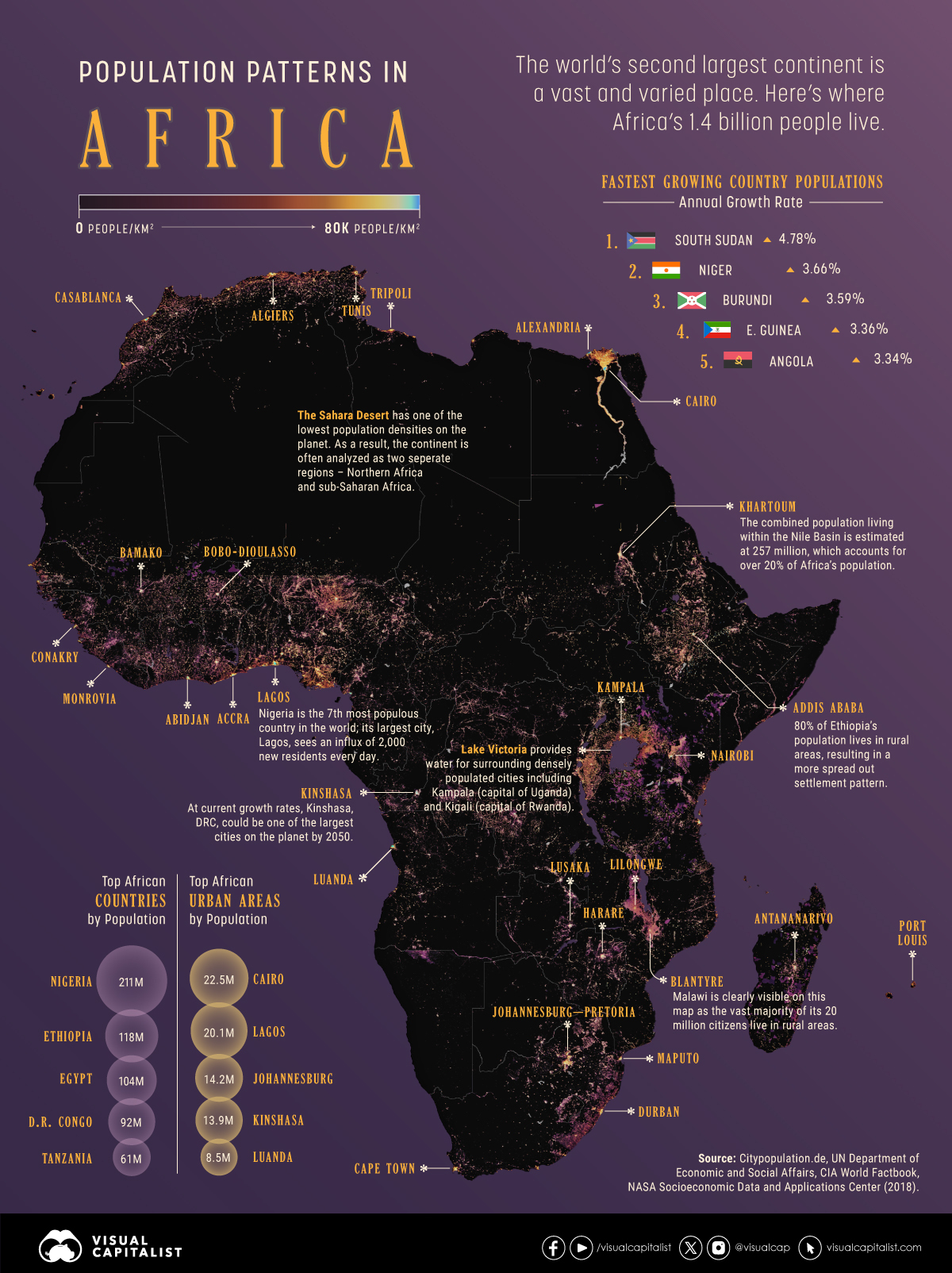population
Mapped: North America Population Patterns by Density
![]() See this visualization first on the Voronoi app.
See this visualization first on the Voronoi app.
Mapped: North America Population Patterns by Density
This was originally posted on our Voronoi app. Download the app for free on iOS or Android and discover incredible data-driven charts from a variety of trusted sources.
From the icy expanses of the Arctic to the warm Caribbean sea, the North American continent covers nearly 25 million square kilometers, or about 15% of the Earth’s land area. Populating this vast region are nearly half a billion people, spread out from coast to valley, along the edges of arid scrublands and rainforests.
We visualize a map of North America population patterns, including Central America and the Caribbean, with spikes illustrating densely populated areas.
Data for this map is sourced from Statistics Canada, the World Bank, and WorldPop—a research group based out of the University of Southampton that tracks population growth and movement across the globe.
Ranked: Countries and Territories by Population Density
Deep in the Atlantic, seen as a small dot near Haiti on the map, the island state of Bermuda is the most densely populated jurisdiction on the continent. Measuring just 53 km² in area, and home to 65,000 people, results in an average population density of 1,266 people per km².
Also in the Caribbean, Barbados ranks second with an average population density 642 people/km², followed by Aruba, ranked third-highest at 550 people/km².
| Rank | Country/Territory | Average Population Density (per km²) | Area (km²) |
|---|---|---|---|
| 1 | 🇧🇲 Bermuda | 1,226 | 53 |
| 2 | 🇧🇧 Barbados | 642 | 439 |
| 3 | 🇦🇼 Aruba | 550 | 193 |
| 4 | 🇭🇹 Haiti | 423 | 27,750 |
| 5 | 🇵🇷 Puerto Rico | 360 | 8,897 |
| 6 | 🇲🇶 Martinique | 325 | 1,130 |
| 7 | 🇸🇻 El Salvador | 303 | 21,040 |
| 8 | 🇱🇨 Saint Lucia | 292 | 617 |
| 9 | 🇻🇮 Virgin Islands | 285 | 346 |
| 10 | 🇻🇨 Saint Vincent & the Grenadines | 267 | 389 |
| 11 | 🇯🇲 Jamaica | 257 | 10,992 |
| 12 | 🇬🇵 Guadeloupe | 252 | 1,628 |
| 13 | 🇩🇴 Dominican Republic | 234 | 48,442 |
| 14 | 🇧🇶 Netherlands Antilles | 229 | 800 |
| 15 | 🇹🇹 Trinidad & Tobago | 212 | 5,128 |
| 16 | 🇦🇬 Antigua & Barbuda | 214 | 440 |
| 17 | 🇻🇬 British Virgin Islands | 206 | 153 |
| 18 | 🇰🇳 Saint Kitts & Nevis | 176 | 269 |
| 19 | 🇦🇮 Anguilla | 175 | 91 |
| 20 | 🇰🇾 Cayman Islands | 168 | 264 |
| 21 | 🇬🇹 Guatemala | 165 | 108,889 |
| 22 | 🇨🇷 Costa Rica | 101 | 51,100 |
| 23 | 🇨🇺 Cuba | 102 | 109,884 |
| 24 | 🇭🇳 Honduras | 94 | 112,492 |
| 25 | 🇩🇲 Dominica | 91 | 750 |
| 26 | 🇲🇸 Montserrat | 91 | 103 |
| 27 | 🇹🇨 Turks & Caicos Islands | 75 | 616 |
| 28 | 🇲🇽 Mexico | 65 | 1,972,550 |
| 29 | 🇵🇦 Panama | 60 | 74,177 |
| 30 | 🇳🇮 Nicaragua | 54 | 130,370 |
| 31 | 🇺🇸 U.S. | 35 | 9,834,000 |
| 32 | 🇧🇸 The Bahamas | 29 | 13,880 |
| 33 | 🇵🇲 Saint-Pierre & Miquelon | 24 | 242 |
| 34 | 🇧🇿 Belize | 17 | 22,966 |
| 35 | 🇨🇦 Canada | 4 | 9,984,670 |
| 36 | 🇬🇱 Greenland | 0 | 2,166,086 |
| 37 | 🇺🇸 Navassa Island | 0 | 5 |
Naturally the largest countries on the continent—Canada, the U.S., and Mexico—have some of the lowest average population densities compared to other nations in the region.
However, thanks to their size, their overall population distribution is more apparent on a map of this scale. In Canada, the Greater Toronto Area is home to one-fifth the country’s entire population. In stark contrast, the rest of the country seems almost empty—averaging just 4 people/km².
Major U.S. cities—New York, Chicago, and San Francisco—also stand out, though the more regular dispersion of Americans, particularly in the Northeast, South, and Midwest can also be seen.
Interestingly, Monterrey in Mexico jumps out on the map; the city is built at the foot of Cerro de la Silla, and several districts are densely populated as a result.
Ranked: Continents by Population Density
How does North America compare to the other continents by population density?
Unsurprisingly, thanks to its large land area, as well as comparatively smaller population, North America is one of the least densely populated continents in the world, beaten only by Oceania, which averages 5 people/km², and Antarctica.
| Rank | Continent | Average Population Density (per/km²) |
|---|---|---|
| 1 | Asia | 149 |
| 2 | Africa | 49 |
| 3 | Europe | 32 |
| 4 | South America | 25 |
| 5 | North America | 25 |
| 6 | Oceania | 5 |
| 7 | Antarctica | 0 |
Source: World Population Review.
In comparison, Asia, while being the largest continent, is also home to 60% of the global population, and averages 149 people/km².
Countries
Mapped: Africa’s Population Density Patterns
We map out Africa’s population density, spotlighting the continent’s most populous countries and cities.

Mapped: Africa’s Population Density Patterns
This was originally posted on our Voronoi app. Download the app for free on iOS or Android and discover incredible data-driven charts from a variety of trusted sources.
Africa, the world’s second largest continent, spans over 30 million km2, home to the not only world’s biggest desert but also the second-largest tropical rainforest, and of course, approximately 1.4 billion people.
In this infographic, we map out the continent’s population density patterns. It’s a prime example of how humans congregate near fresh water and around the edges of natural obstacles.
This population density data comes from the Gridded Population of the World dataset created by the Center for International Earth Science Information Network (CIESIN) hosted by NASA’s Socioeconomic Data and Applications Center (SEDAC).
Ranked: Most Populous African Countries
Africa’s second largest economy, Nigeria, is also its most populous: more than 220 million people live in this diverse West African country with 250 ethnic groups, speaking over 500 different languages.
And the nation is only growing. By 2100, it’s estimated that the Nigerian population could be more than three-fold its current size, at nearly 800 million residents, becoming the second-most populous country in the world.
| Rank | Country | Population |
|---|---|---|
| 1 | 🇳🇬 Nigeria | 224M |
| 2 | 🇪🇹 Ethiopia | 127M |
| 3 | 🇪🇬 Egypt | 112M |
| 4 | 🇨🇩 DRC | 102M |
| 5 | 🇹🇿 Tanzania | 67M |
| 6 | 🇿🇦 South Africa | 59M |
| 7 | 🇰🇪 Kenya | 55M |
| 8 | 🇺🇬 Uganda | 49M |
| 9 | 🇸🇩 Sudan | 48M |
| 10 | 🇩🇿 Algeria | 46M |
Source: UN Department of Economic and Social Affairs, World Population Prospects. (2022)
Across the continent, along its eastern side, Ethiopia, is the second-most populous country on the continent. Unlike Nigeria—which has nearly 20 cities with at least half a million residents—more than three-quarters of Ethiopia’s 127 million people live in rural communities.
Ranked third, Egypt (112 million) is the only North African country in the top five by population. The Democratic Republic of the Congo (DRC) comes in fourth (102 million), with Tanzania (67 million) rounding out the top five.
Ranked: Fastest Growing African Countries By Population
In the year 1900, Africa accounted for 9% of the world’s population. Currently its share stands close to 18%. By 2025, the International Monetary Fund (IMF) expects one in four people in the world to live in Africa, and says the continent’s demographic transition has the power to “transform the world.”
The most populous African countries (DRC, Tanzania, Ethiopia, Nigeria, and Egypt) will contribute the lion’s share to this growth of course, but within the continent, other countries are also seeing relatively rapid population growth.
| Rank | Country | Growth Rate |
|---|---|---|
| 1 | 🇸🇸 South Sudan | 4.78% |
| 2 | 🇳🇪 Niger | 3.66% |
| 3 | 🇧🇮 Burundi | 3.59% |
| 4 | 🇬🇶 Equatorial Guinea | 3.36% |
| 5 | 🇦🇴 Angola | 3.34% |
| 6 | 🇧🇯 Benin | 3.31% |
| 7 | 🇺🇬 Uganda | 3.22% |
| 8 | 🇨🇩 DRC | 3.13% |
| 9 | 🇹🇩 Chad | 3.05% |
| 10 | 🇲🇱 Mali | 2.93% |
Source: CIA World Factbook.
In South Sudan, the world’s newest country, the population is growing at nearly 5% every year. The broader sub-Saharan population meanwhile is growing at half that rate. Aside from a higher fertility rate, the country is also seeing an influx of refugees from conflict areas in neighboring Sudan.
While no other African nation is quite matching South Sudan’s population growth, several of Africa’s poorer economies are also posting an annual population increase of more than 3% including Niger, Burundi, and Chad.
Ranked: Most Populous African Cities
About half of Africa lives in urban areas, which is less than the global average of 57%. The 10 most populous cities on the continent together account for about 115 million people, more than 1.5x the UK’s total population.
Egypt’s capital, Cairo, built along the banks of the Nile, is home to more than 22 million residents, and ranks as Africa’s largest city. This bustling metropolis has stood as an important trade juncture between continents for more than 1,400 years—and is still somehow one of Egypt’s younger cities.
| Rank | City | Country | Population |
|---|---|---|---|
| 1 | Cairo | 🇪🇬 Egypt | 22.2M |
| 2 | Lagos | 🇳🇬 Nigeria | 21.4M |
| 3 | Kinshasa | 🇨🇩 DRC | 15.0M |
| 4 | Johannesburg | 🇿🇦 South Africa | 14.8M |
| 5 | Luanda | 🇦🇴 Angola | 9.0M |
| 6 | Khartoum | 🇸🇩 Sudan | 6.9M |
| 7 | Abidjan | 🇨🇮 Cote d'Ivoire | 6.6M |
| 8 | Nairobi | 🇰🇪 Kenya | 6.6M |
| 9 | Accra | 🇬🇭 Ghana | 6.4M |
| 10 | Dar es Salaam | 🇹🇿 Tanzania | 6.0M |
Source: Urban agglomerates (2023) Citypopulation.de.
Down south, across the Sahara desert, and near the shores of the Atlantic, Nigeria’s former capital Lagos has slightly more than 21 million people. The city’s name comes from the numerous surrounding lagoons, and its original name in Yoruba, “Eko”, also means “lake.” Population estimates for the city are often disputed because of several different administrative regions, but also because of how fast Lagos is growing: it’s estimated 2,000 new residents move in every day.
Kinshasa, the capital of the DRC ranks third with about 15 million residents, and is slated to become the fourth largest city in the world, with 35 million people, by 2050.
Johannesburg, South Africa (15 million), and Luanda, Angola (9 million) round out the top five most populous African cities.
-

 Education1 week ago
Education1 week agoHow Hard Is It to Get Into an Ivy League School?
-

 Technology2 weeks ago
Technology2 weeks agoRanked: Semiconductor Companies by Industry Revenue Share
-

 Markets2 weeks ago
Markets2 weeks agoRanked: The World’s Top Flight Routes, by Revenue
-

 Demographics2 weeks ago
Demographics2 weeks agoPopulation Projections: The World’s 6 Largest Countries in 2075
-

 Markets2 weeks ago
Markets2 weeks agoThe Top 10 States by Real GDP Growth in 2023
-

 Demographics2 weeks ago
Demographics2 weeks agoThe Smallest Gender Wage Gaps in OECD Countries
-

 Economy2 weeks ago
Economy2 weeks agoWhere U.S. Inflation Hit the Hardest in March 2024
-

 Green2 weeks ago
Green2 weeks agoTop Countries By Forest Growth Since 2001














